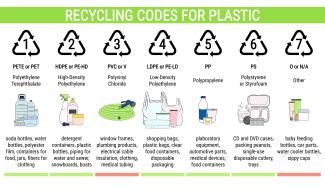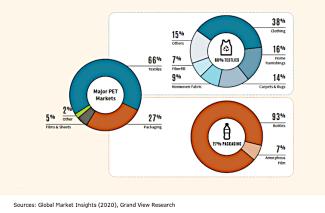By Swapna Nelaballi
PET plastics: leading the way to ‘plastification’ of our planet
Plastic waste is a global crisis. Much of this waste never fully disappears. It simply breaks down into smaller and smaller pieces, that in time end up everywhere; in our air, in our soil, in fresh- and saltwater, in plants and animals, and in us! Despite the scale of this crisis, our throwaway culture continues to ensure an uninterrupted and alarmingly growing production, usage, and (careless) disposal of plastics. If we continue business as usual, plastic production will double by 2040, and so will our problems.

Credit: M. Malinika Source: Adobe Stock # 425526925
Of the many types of plastics, PET (for polyethylene terephthalate), or plastic #1, or polyester (in its fiber form), is among the most commonly used plastics. Each year, we produce close to one hundred million metric tons of PET, or the combined weight of close to 1,912 fully loaded Titanics! Since its invention in the 1940s, PET quickly gained superstar status among plastics, as a cheap (to purchase), lightweight material, with a huge variety of uses, from the production of single-use plastic products like water and soda bottles, to polyester clothing, to cuddly toys.
Since PET is commonly marketed as highly recyclable, BPA-free and “safe,” one might wonder what all the hoopla is about?
Producing virgin (new) PET to meet our insatiable demand accrues huge environmental costs. Before any PET product reaches us, it has already taken a toll on our environment; by using large quantities of non-renewable resources (fossil fuels), in an energy-guzzling process that spews out greenhouse gasses and other hazardous by-products. And then there’s what happens once you toss them away. The highly recyclable PET is rarely recycled. Only about 11% (including polyester) is recycled, while the rest, weighing about 1700 fully loaded Titanics, is burned, littered, or, most often, landfilled.

Infographic source: page 23 Defend Our Health Report
Irrespective of what our behavior may suggest, we seem to at least acknowledge the fact that PET waste is bad for our planet and for us. But, another equally worrisome PET problem continues to be swept under the rug.
Bleeding Toxics: More than Just a Waste Problem
Toxic chemicals escaping from plastics into our environment is old news; remember our infamous friend BPA. As the world disputed the risks of BPA, the industry quickly replaced BPA with “BPA-free” alternatives that were found to be “just as bad.” Amidst all this chatter about BPA and its siblings, whispers of yet another highly toxic chemical went unheard.
Over 15 years ago, we were told that PET plastics leach (or release) a toxic heavy metal called antimony (Sb). Antimony (specifically antimony trioxide) is used as the dominant catalyst to hasten the process of producing PET plastic. However, post production, some antimony remains in the plastic product, with the potential to enter into the food and drinks it holds, and the environment. Since then, there has been growing evidence in support of this finding. Chronic exposure to antimony compounds may lead to serious health issues including cancer, heart, liver and kidney problems.
But, unlike the BPA saga, these findings didn’t take the consumer world by storm, few were up in arms, and “antimony-free” PET plastics didn’t flood the market. Instead, the powerful plastics lobby left no stone unturned to dispel concerns surrounding antimony, claiming that levels in most beverage brands that use PET plastic packaging were negligible if not undetectable, and did not pose a risk to human health. And, PET plastics continue to be marketed as “safe.”
But, do not be blinded by marketing tactics, warns a recent study by our partners at Defend Our Health.
Think before you drink: toxic brews within PET plastic bottles
Defend Our Health, a non-profit organization looking into the impacts of petrochemical plastics on public health, commissioned an independent study earlier this year to check antimony concentrations in popular beverages. The organization purchased PET plastic-bottled beverages from 20 leading brands including Pepsi and Coca-Cola. These were then shipped off to two separate testing facilities, including our Healthy Stuff Lab, at the Ecology Center, Ann Arbor, Michigan, to check for antimony concentrations. While Vanguard Labs in Olympia, Washington, tested the beverage and bottles separately for antimony; we at the Ecology Center tested bottles from 14 of the 20 brands using a different methodology.
A detailed study report was made publicly available in July 2022. The findings are alarming. In 40% of the beverages, antimony levels in the drink itself exceeded 1 part per billion (ppb); the limit set by the California public health goal for antimony in drinking water. Of the tested beverages, the highest antimony concentrations were found in Campbell Soup Company’s V8 Juice (3.45 ppb), Coca Cola regular soda (2.20 ppb), and PepsiCo’s Gatorade Blue Raspberry (1.78 ppb). The entire list may be viewed here. Chronic exposure to such concentrations can cause liver damage and increases our risk of organ toxicity, heart disease, and cancer.
Coming to the PET plastic itself, antimony concentrations in the bottles were between 216-321 parts per million (ppm), which is worrisome as PET plastic continues to leach antimony when exposed to heat, light, soda, juice, or when it is stored for long periods of time.
The study also highlighted the fact that a large proportion (over 60%) of PET goes into manufacturing polyester-based textiles, largely catering to the extremely wasteful ‘fast fashion’ industry that churns out new clothing collections much more frequently than clothes are actually worn before being thrown away. Less than 1% of polyester clothing is recycled! Like PET plastic packaging, polyester clothing releases antimony that can be orally ingested, absorbed by our skin, and inhaled from indoor and outdoor air.
Further, like in most cases of environmental contamination, the risk to health from antimony exposure is disproportionately borne by certain groups. Young children are particularly at risk, given their behavior of putting their hands, clothing, and toys in their mouths, and are routinely overexposed to unsafe levels of antimony. As per Defend Our Health’s calculations, young children, especially babies and toddlers, are exposed to almost three times more antimony (per bodyweight) than are adults in the US.
People of color from low income neighborhoods also face a greater health risk from higher levels of exposure to antimony. Pollution-spewing petrochemical plastic manufacturing plants are most often located in close proximity to communities of color and lower-income neighborhoods that are already dealing with environmental contamination from many other sources.
Lastly, antimony is just one of many reasons why virgin PET plastic production, usage and disposal, is deleterious. More than 10,000 chemicals are involved in producing plastics. Of these, 24% including antimony are known to be harmful to humans and planetary health. But, we know next to nothing about the safety of a whopping 39% of the remaining chemicals.
There is little doubt that PET plastics are unsafe, unjust, and unsustainable. But, production continues unabated, and, not-so-shockingly, petrochemical plastic industries are instead pouring billions of dollars into constructing new plants, to pump out a higher volume of plastics.
The proposed Corpus Christi Polymers plant in Texas, when operational, will be the largest PET plant in the world that will produce 1.1 million tons per year, increasing the production of PET plastics in the US by 25%. A second plant is proposed for the area of Louisiana known as “cancer alley.” If this plan comes to fruition, this plant would produce 1.6 million tons of mono-ethylene glycol or MEG; an essential chemical that is used in the production of 80% PET plastics and polyester. Production of MEG is known to release cancer-causing chemicals into the environment.
Drastic times call for drastic measures
If we were to completely stop producing plastic today, we will still be left with an insurmountable challenge: the mammoth task of dealing with 5000 million tons (as of 2015) of plastic waste, entombed in landfills. Do we really need to add to the challenge?
One way out of this conundrum is to change the way we produce PET plastics, as advocated by Defend Our Health. The report lists several measures that involve phasing out production of virgin PET plastics, and replacing them with recycled and/or 100% non-toxic biobased PET. This will take time, effort, and sustained advocacy. But it is possible.
In the meantime, it is more important to (immediately) stop the use of toxic chemicals such as antimony. Defend Our Health has conducted assessments of alternatives that could be used as catalysts in PET production instead of antimony. They found that safer, effective, and economically viable options are available. With better alternatives at hand, PET plastic manufacturers now have no reason to continue business-as-usual whilst poisoning us and our environment with deadly toxins. It is time for those of us with agency to fervently advocate for better practices, compelling major brands to end their use of toxic plastics.
Join the fight to curb plastic pollution.


